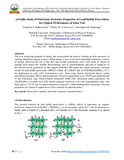| dc.contributor.author | Kipkwarkwar, Truphena J. | |
| dc.contributor.author | Nyawere, Philip. W. O. | |
| dc.contributor.author | Maghanga, Christopher. M. | |
| dc.date.accessioned | 2020-07-23T12:07:41Z | |
| dc.date.available | 2020-07-23T12:07:41Z | |
| dc.date.issued | 2019-09 | |
| dc.identifier.uri | http://10.1.130.140:8080/xmlui/handle/123456789/362 | |
| dc.description | Full text | en_US |
| dc.description.abstract | The ever increasing demand of energy has necessitated the need of coming up with measures of
seeking alternative energy sources. Solar energy is one
of energy. However,the use of the first and second generations solar cells made of silicon in
making solar panels has notable shortcomings such as unaffordability and lack of longevity of
the electric power generated. In this regard, therefore, We report the initial electronic structure
results of lead halide perovskite (APbX3) where (X
for application in solar cells. Calculations were done using density functional theory withi
generalized gradient (GGA) approximations, Projector augmented wave (PAW) pseudopotentials
of the functional type Perdew-Burke-Ernzerhof (PBE).The calculated lattice parameter for CH3NH3PbI3 is foundto be 6.27A which compares relatively well with experimental value. Our band gap is 1.74 eV and is underestimated as expected. Understanding these electronic structure
properties are critical in application of this material in optoelectronics. | en_US |
| dc.language.iso | en | en_US |
| dc.publisher | KABARAK UNIVERSITY | en_US |
| dc.subject | Perovskites, halides, electronic structure,optoelectronics. | en_US |
| dc.title | ab Initio Study of Electronic Structure Properties of Lead Halide Perovskites for Optical Performance of Solar Cell | en_US |
| dc.type | Article | en_US |

